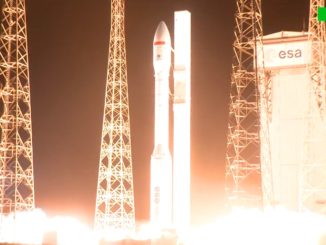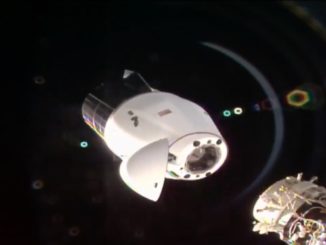EDITOR’S NOTE: The launch of the Falcon Heavy rocket with the ViaSat 3 Americas mission has been delayed to no earlier than April 24.

SpaceX test-fired 27 main engines on a Falcon Heavy rocket Thursday in Florida, clearing a hurdle before installing three commercial communications satellites on the launcher for a mission to geostationary orbit later this month.
The test-firing at 12 p.m. EDT (1600 UTC) Thursday lasted less than 10 seconds, enough time for the Falcon Heavy rocket’s 27 Merlin 1D main engines to ignite and throttle up to generate some 5.1 million pounds of thrust. Hydraulic hold-down clamps kept the 3.1-million-pound launcher firmly on the ground at NASA’s Kennedy Space Center.
Working out of a firing room leased in NASA’s Launch Control Center, SpaceX’s launch team supervised a 50-minute automated countdown sequence to load kerosene and liquid oxygen propellants into the Falcon Heavy. Control of the countdown passed from a ground computer to the rocket’s flight computer at T-minus 1 minute, the propellant tanks were pressurized, and the engines lit moments before the clock reached zero.
SpaceX completed the static fire test without the Falcon Heavy’s payload fairing or the three satellites the rocket will haul into an orbit near geostationary altitude some 22,000 miles (36,000 kilometers) over the equator.
Ground crews will lower the rocket horizontal Friday and roll it back to the hangar a quarter-mile south of pad 39A. The payload compartment will be installed on the rocket inside the hangar this weekend, then the rocket will be return to pad 39A and raised vertical for a launch attempt Tuesday, April 18.
Following the static fire test Thursday, SpaceX confirmed the mission remains on track for liftoff during a 57-minute launch window Tuesday opening at 7:29 p.m. EDT (2329 GMT).
Static fire! SpaceX has fired up a Falcon Heavy rocket on pad 39A at Kennedy Space Center. This hold-down test-firing is in preparation for launch next week with the Viasat 3 Americas broadband satellite.
Read more in our preview: https://t.co/yFpulNn0QW pic.twitter.com/VK1UoWuzZF
— Spaceflight Now (@SpaceflightNow) April 13, 2023
The satellites slated to ride the Falcon Heavy into orbit have been prepared for launch at a separate payload processing facility at Cape Canaveral.
The primary payload is ViaSat 3 Americas, a bus-sized spacecraft built by Boeing to beam internet signals across the Americas and adjacent maritime regions. Rural households, government and military users, airline passengers, and ships will access the internet through ViaSat 3 Americas after its launch, deployment, and commissioning over the next few months.
Owned by Viasat headquartered in Carlsbad, California, the spacecraft weighs about 6 metric tons — more than 13,000 pounds — and carries a sophisticated Ka-band payload. The satellite will unfurl solar panels in orbit to generate more than 30 kilowatts of power, more than a quarter the electrical power produced by all the solar arrays on the International Space Station.
Boeing said the ViaSat 3 Americas satellite is the most powerful spacecraft platform the company has ever developed for a customer. The satellite has some of the largest antenna reflectors ever sent into space, and will rely on all-electric propulsion for fine orbital maneuvers and station-keeping in geostationary orbit, where it will fly in lock-step with Earth’s rotation.
That will allow the ViaSat 3 Americas spacecraft to hover over the same geographic position along the equator at 88.9 degrees west longitude, providing coverage over North and South America and adjacent maritime regions. Viasat and Boeing are working on two more satellites to provide similar internet service over Europe, North Africa, and the Middle East, and the Asia-Pacific region.
Smaller rideshare communications satellites for Astranis and Gravity Space, both commercial startups, will hitch a ride to geostationary orbit on the Falcon Heavy rocket.
Astranis’s satellite, called Arcturus with a launch weight around 660 pounds (300 pounds), will provide broadband internet services to Alaska. Gravity Space’s microsatellite will help an Indonesian company retain regulatory rights to an orbital slot in geostationary orbit with the International Telecommunication Union, which doles out geostationary positions to commercial satellite operators.
The launch Tuesday will mark the sixth flight of a Falcon Heavy rocket overall, and the second of as many as five Falcon Heavy missions on SpaceX’s schedule this year.
The heavy weight of the payload, coupled with the high-altitude deployment, will not leave enough leftover propellant in the Falcon Heavy’s three first stage boosters for recovery maneuvers. All three boosters will be disposed in the Atlantic Ocean, and are stripped of their landing legs and grid fins.
The center core for the ViaSat 3 Americas mission is brand new, while the side boosters are reused from previous SpaceX missions.
Email the author.
Follow Stephen Clark on Twitter: @StephenClark1.



